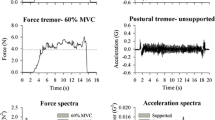Abstract
Tensotremorography was used to record voluntary forces and to study the characteristics of the involuntary and voluntary components of isometrically recorded hand strength. The frequency ranges for changes in the spectral density of oscillations recorded here supported the existence of two suprasegmental systems associated with voluntary control and continuous regulation of force maintaining or holding a posture. Cross-correlation analysis of hand force maintained in conditions of visual feedback in normal conditions and in conditions of central disorders of the movement control system is presented.
Similar content being viewed by others
REFERENCES
S. Kasitski and S. P. Romanov, “Organization of the electrical activity of different muscle groups in rats during locomotion,” Fiziol. Zh. SSSR, 64,No. 10, 1426–1435 (1978).
S. P. Romanov, “Modeling the mechanisms of the spinal level of control of muscle contraction,” Fiziol. Zh. SSSR, 60,No. 10, 1508–1517 (1974).
S. P. Romanov, “Studies of a model of the role of Renshaw cells in controlling motoneuron discharges,” Fiziol. Zh. SSSR, 62,No. 4, 528–536 (1976).
S. P. Romanov, “Inhibitory reverse connections in the chain regulating motoneuron discharges,” Ros. Fiziol. Zh. im. I. M. Sechenova, 82,No. 1, 33–44 (1996).
S. P. Romanov, “Conceptual approaches to identifying the functions of the structural organization of a neural network,” Zh. Vyssh. Nerv. Deyat., No. 2, 320–343 (2000).
S. P. Romanov, A. F. Yakimovskii, and M. G. Pchelin, “A tensometric method for quantitative assessment of tremor,” Ros. Fiziol. Zh. im. I. M. Sechenova, 82,No. 2, 118–123 (1996).
S. P. Romanov, M. G. Pchelin, and A. F. Yakimovskii, “Characteristics of an isometrically recorded tremor in lesions of the extrapyramidal system,” Ros. Fiziol. Zh. im. I. M. Sechenova, 83,No. 3, 135–141 (1997).
B. F. Tolkunov, A. A. Orlov, and B. P. Mochenkov, “Neuron activity in the monkey neostriatum during operant behavior,” Neirofiziologiya, 1,No. 2, 132–140 (1993).
H. Asanuma, “Neural basis of motor learning in mammals,” in: Fourth IBRO World Congress of Neuroscience, 9–14 July 1995, Kyoto, Japan. Abstracts, Rapid Communications, Oxford, New York (1995), RL16, p. 4.
J. T. Buchanan and D. R. McPherson, “The neuronal network for locomotion in the lamprey spinal cord. Evidence for the involvement of commissural interneurons,” J. Physiol. (Paris), 89,No. 4–6, 221–223 (1995).
J. L. Contreras-Vidal and G. E. Stelmach, “A neural model of basal ganglia-thalamocortical relations in normal and parkinsonian movement,” Bio. Cybernetics, 73, 467–476 (1995).
E. V. Evarts and W. T. Thach, “Motor mechanisms of the CNS: cerebello-cerebellar interrelations,” Ann. Rev. Physiol., 31, 451–498 (1969).
S. Grillner, “Neural networks for vertebrate locomotion,” Sciences Amer., 274,No. 1, 48–53 (1996).
F. Horak and J. Frank, “Three separate postural systems affected in parkinsonism,” in: Motor Control VII. Proceedings of the VIIth International Symposium on Motor Control Held in Borovets, Bulgaria, June 21–25, 1993, D. G. Stuart (ed.), Motor Control Press, Tucson (1996), pp. 343–346.
M. Ito, The Cerebellum and Neural Control, Raven Press, New York (1984).
K. Kultas-Ilinsky and I. A. Ilinsky (eds.), Basal Ganglia and Thalamus in Health and Movement Disorders, Kluwer Academic, Plenum Publishers, New York, Boston, Dordrecht, London, Moscow (2001).
K. Lukowiak, “Central pattern generators: some principles learned from invertebrate model systems,” J. Physiol. (France), 85,No. 2, 63–70 (1991).
S. P. Romanov, “Information processes in neuron network of muscle contraction control. Vestibular and neutral front,” in: Proceedings of the 12th International Symposium on Posture and Gait, Matsumoto, Japan, 3–7 October, 1994, Elsevier Science, Amsterdam (1994), pp. 457–460.
S. P. Romanov, “Proprioceptive feedback as a homeostatic mechanism of multiparametric motor control,” in: Motor Control VII. Proceedings of the VIIth International Symposium on Motor Control Held in Borovets, Bulgaria, June 21–25, 1993, Motor Control Press, Tucson (1996), pp. 141–145.
S. P. Romanov, “Specific principles of motor control system organization,” in: Motor Control VIII. Proceedings of the VIIIth International Symposium on Motor Control, 23–27 June, 1996, Borovetz, Academic Publishing House, Sofia (1996), pp. 265–268.
G. F. Rossi and A. Zanchetti, The Brain Stem Reticular Formation. Anatomy and Physiology (1957).
Author information
Authors and Affiliations
Rights and permissions
About this article
Cite this article
Romanov, S.P., Aleksanyan, Z.A. & Manoilov, V.V. Characteristics of Tremor in Normal Subjects and in the Diagnosis and Treatment of Parkinsonism. Neurosci Behav Physiol 34, 389–398 (2004). https://doi.org/10.1023/B:NEAB.0000018751.74369.89
Issue Date:
DOI: https://doi.org/10.1023/B:NEAB.0000018751.74369.89




